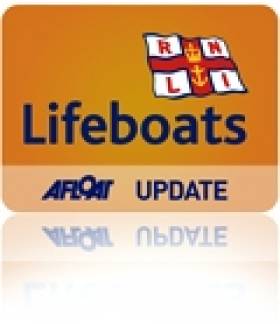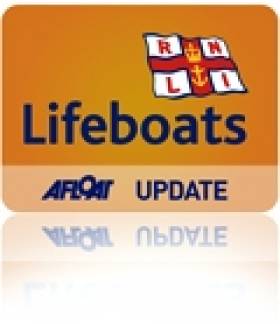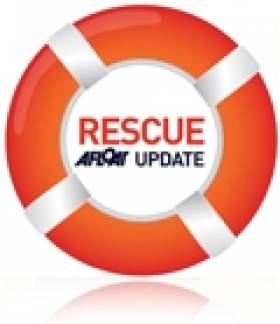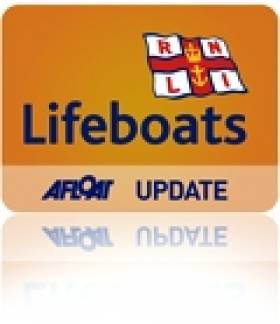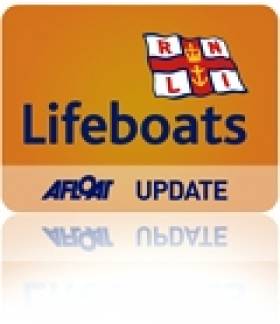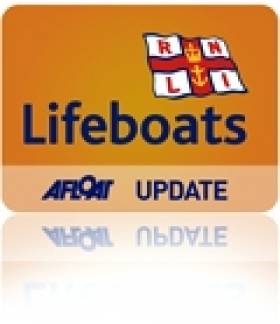Displaying items by tag: Lifeboat
Lifeboat Rescues Stranded Sailor (and his dog) on Lough Derg
At 09.20hrs on Thursday morning, June 30, Lough Derg RNLI lifeboat, Toshiba Wave Warrior, went to the assistance of a person, who had been stranded since the previous afternoon, when his vessel had grounded on rocks at the mouth of the river Shannon in Terryglass Bay, at the most northerly part of the lake. The skipper of the vessel is a diabetic.
At 09.05hrs, Thursday June 30, Lough Derg RNLI Lifeboat was requested to launch by Valentia Coast Guard, to assist a person whose vessel was on rocks close the mouth of the river Shannon, in Terryglass Bay. The lifeboat with helm Eleanor Hooker, Peter Clarke and Robbie Garland on board, launched at 09.20hrs. Winds were south-westerly, Force 2-3, visibility was very good. The lifeboat was alongside the casualty vessel, a 23ft cruiser, at 09.45hrs. There was one person and his faithful dog on board.
The vessel had been grounded since the previous afternoon, and the skipper and his dog had remained stranded overnight. The skipper, a senior individual, told crew that he had got into the water and made two attempts to get the boat off the rocks himself, but without success. The alarm was raised by a local who heard his calls for help.
When the lifeboat arrived on scene, the person was quiet but alert and able to give a full history of events, he had kept warm overnight. He was assessed by Lifeboat crew and didn't give any medical history.
With a lifeboat volunteer on board, the vessel was taken off the rocks and to a landing point at Portumna Bridge closeby, 10.10hrs. Lifeboat Operations Manager Charles Stanley-Smith had called ahead and asked Deputy Launching Authority Fergal Kerney, who was in the area, to meet the lifeboat with food and a warm drink for the casualty.
Two friends of the person, who had been looking for him after it was noticed that his vessel was not at its mooring, also met the lifeboat at Portumna Bridge. They informed crew that the person suffered from diabetes.
The person, alert and able, was given food and drink and immediately taken for a medical assessment. A Garda from Portumna Garda Station was also on scene and Valentia Coast Guard had an ambulance on standby should it have been required. The lifeboat returned to station and was ready for service again at 11.15hrs
Two Successful Rescues by Bangor Lifeboat
On Wednesday 22nd June at 8.20pm Belfast Coastguard received information that an 18ft speedboat with 2 persons aboard had struck rocks close to Groomsport. Volunteer crew quickly assembled and launched RNLI Bangor Lifeboat which proceeded at full speed to the stricken vessel. Thankfully the two people onboard the stranded vessel were able to scramble safely ashore before the Lifeboat arrived on scene. Crew aboard the Lifeboat rigged a tow line and towed the speedboat to the safety of Groomsport Harbour.
On Saturday 25th June at 1.15pm volunteer RNLI crew were alerted by rescue pager that a 35ft yacht with 3 people onboard had lost all steering and required assistance. Belfast Coastguard gave the vessels location as 2½ nautical miles north east of Bangor Harbour. Bangor Lifeboat was launched and escorted the sailing vessel close to entrance of Bangor Harbour were a tow line was rigged. The yacht was then towed to the safety of Bangor Marina.
Kyle Marshall, senior RNLI volunteer helmsman at Bangor Lifeboat Station took this opportunity to stress five very important sea safety tips for anyone going afloat. He said. 'Always wear a lifejacket, secondly check your engine and fuel, thirdly tell others where you are going, fourthly carry some means of calling for help and final always check the weather and tides' He added 'We're happy that the crews aboard both vessels are now safely ashore'.
Lough Derg Lifeboat Tows Cruiser to Safety
At 19.26hrs, Saturday June 25, Lough Derg RNLI Lifeboat was requested to launch by Valentia Coast Guard, to assist a person whose vessel had grounded on rocks west of the Scilly Islands, in Scarriff Bay on Lough Derg. The lifeboat with helm Eleanor Hooker, Peter Clarke and Colin Knight on board, launched at 19.40hrs. Winds were southerly, Force 3, visibility was good. The lifeboat was alongside the casualty vessel, a 32ft cruiser, at 19.58hrs.
The person on board, senior but with a lifetime of boating experience, was quite unsettled by his experience, having misread his location. He was reassured by the lifeboat crew. After a thorough examination of the vessel, which was not holed, it was taken off the rocks and into safe water. With a crew member on board, the casualty vessel was taken under an alongside tow, via Scarriff Bay, up the Scarriff river in County Clare to his mooring. The vessel was tied safely alongside at 21.20hrs.
The lifeboat returned to station and was ready for service again at 21.40hrs.
Hull Damage To Blame for Stranded Divers
The accident that left four divers stranded off the Wexford coast last weekend was caused by damage to their boat's hull.
Divernet reports that the accident occurred when a section of tubing at the RIB's bow broke away from the hull.
The search operation, which included four RNLI lifeboats, an Irish Coast Guard helicopter and shore unit, was launched last Friday night when the group of divers failed to return to shore.
The divers were rescued at 6am on Saturday morning near the Saltee Islands, where they were found clinging to their upturned RIB.
Dramatic video of the divers' rescue was posted earlier this week on Afloat.ie.
Mayday Prompts Launch of Both Baltimore Lifeboats
Valentia Coast guard first raised the alert at 08:48 this morning requesting the launch of the all weather lifeboat Hilda Jarrett, 3 minutes later the inshore life boat Bessie was tasked too and with it's superior engine power was first on scene. They found the potting boat within 50 metres of the rocks at the North West point of the Western Calf Island. The fishermen had set an anchor in an attempt to keep the boat off the rocks, but the anchor had dragged and they were left holding into their pot lines for safety. A difficult task in Force 5 westerly winds with a 2 metre swell running.
Helm John Kearney manoevred the lifeboat into position and his crew threw a line to the fishermen. The lifeboat then towed the boat upwind and with the assistance of Schull inshore rescue removed the fishing boat from immediate danger.
The allweather lifeboat arrived on scene and stood by until it was clear that there was no further danger. The inshore lifeboat then towed the pot boat to the safety of Schull harbour. The fishermen were unharmed. Helm John Kearney commented ' it was fortunate we arrived when we did another 5 minutes and we would have been pulling the men out of the water'.
Inshore lifeboat Crew : Helm John Kearney, crew Ronan Callanan & Tadhg Collins
Allweather Lifeboat : Coxswain Kieran Cotter, crew Aidan Bushe, Jerry Smith, Cathal Cottrell, Anthony Sheehy, Sean Mc Carthy, Colin Whooley. Slip crew Rianne Smith, Simon Duggan, Gerard Sheehy
Five Escape When Yacht Hits Rocks Off Galway
Five sailors had a lucky escape when their yacht hit rocks off the coast of Galway in the early hours of Saturday morning, the Irish Examiner reports.
The crew of five, who had been taking part in the annual Around Aran Race, launched their liferaft when the boat ran aground and raise the alarm from the shore.
Galway's RNLI lifeboat was dispatched to the abandoned yacht in Galway Bay later that morning.
Dun Laoghaire Lifeboats Aid Three People During Boat Drama
Four people were on board the craft when they got into difficulties off Shanganagh cliffs between Killiney and Bray. One person swam to shore to raise the alarm, two clung to a buoy while another was reported missing.
The RNLI's all-weather (ALB) lifeboat and inshore lifeboat launched at 14.08pm and proceeded to the scene, arriving 15 minutes later.
Dun Laoghaire RNLI volunteer crew recovered two of the casualties on board the inshore lifeboat while the Irish Coast Guard rescue helicopter 116 located the missing person in the water. All three were transfered to the helicopter and taken to Tallaght Hospital for treatment.
Conditions were described as fresh with force four to five winds.
Wicklow Lifeboat Rescue Two Sailors
On scene weather conditions were described as wind westerly force 4 with a 3.5 metre swell. Lifeboat crew Terry Sillery and Brian Sinnot were quickly transferred onto the yacht and successfully cleared the rope obstruction in challenging conditions, a towline was rigged and the lifeboat took the yacht in tow back to Wicklow harbour. The yacht which was on route between Scotland and Plymouth with two people on board was secured safely alongside the South quay by 01-45am on Saturday morning. The lifeboat was then stood down and returned to station.
The crew were Coxswain Nick Keogh , Mechanic Lisa O Leary , Tom McAulay, Dave O'Leary, John Docherty, Tommy Murphy, Terry Sillery and Brian Sinnot.
Ken Robertson Retires as Dun Laoghaire Lifeboat Coxswain
Ken is a well-known local businessman, notably through his newsagents shop on Marine Road in Dun Laoghaire, a location that allowed him to respond quickly whenever the all-weather lifeboat (ALB) was called out.
Initially, he was appointed 2nd coxswain in 1986 and subsequently in 1989 became the successor to the late Eric Offer who was best known as the coxswain of the 'John F. Kennedy' lifeboat that was stationed in Dun Laoghaire from 1967 until 1990.
In 1995, Ken Robertson and the Dun Laoghaire station took delivery of the current station ALB, the RNLB Anna Livia, a state-of-the-art vessel that cost almost €2 million that is capable of reaching a casualty ten miles offshore within 30 minutes and has a range of 250 miles.
In the course of his long career with the RNLI, Ken has been responsible for many notable services including the rescue of a swimmer in Killiney Bay who was saved just yards from a rocky shoreline in gale force winds in 2007. One of the longest calls ever was a 14-hour operation following the tragic loss of four sailors when their yacht, the Debonair collided with a ship close to Dublin Port in 2001.
Mark McGibney will be the new station coxswain effective 1st June. A volunteer crew member and a coxswain since 2002, he is the Sailing Manager at the nearby Royal Irish Yacht Club and lives locally with his wife and two children.
"Ken Robertson is retiring after a long-career as station coxswain during which he saved dozens of lives and rescued hundreds more," said Stephen Wynne, lifeboat operations manager. "All of us at Dun Laoghaire RNLI wish him well in retirement and also extend our gratitude to his wife Margaret who has been fully supportive in spite of the disruption to normal family life that voluntary lifeboat service brings."
During the course of Ken Robertson's service with the RNLI, the Dun Laoghaire ALB launched on service 535 times and saved 60 lives in addition to the rescue of many others. In 2007, he received the Thanks of the Institution for the rescue of the swimmer at Killiney.
Geoffrey was a scuba diving instructor and working in Thailand when the devastating 2004 tsunami struck the island of PhiPhi. He helped save many lives during that time by recovering people from the water and bringing the injured for urgent medical assistance. He also returned to the area to help bring comfort to many families who had lost loved ones by helping to get official identification for those lost in the tsunami. Sadly Geoffrey died shortly after this at the age of 32 and his parents wanted to do something to recognise the work he did in saving lives. Along with other projects they have funded this Atlantic 85 lifeboat in Geoffrey's name.
During the ceremony Roger spoke about Geoffrey and the reason they funded a lifeboat in his memory. "It is very fitting given that Geoffrey saved people from the sea that we are here today to dedicate and hand over this Atlantic 85 to the Red Bay station in Geoffrey's memory. In the same way that he saved people from the sea we are confident that those trained and skilled with this craft will carry out the same courageous acts and rescue people around these shores.
This project has given us something positive to focus on and we wish to stay in very close contact with the station. Geoffrey loved the sea and the natural environment and when we first saw this lifeboat we knew it would be like him – big, powerful, a little bit noisy and very confident. From our very first visit to Red Bay we knew that this was the place for the lifeboat to be stationed in his memory."
In another special tribute well known singer Frances Black, whose father was from Rathlin Island spoke of her love for the area and thanked the Colmers for their gift in Geoffrey's memory. Frances said, "When we were children we used to spend a lot of time up and around this area travelling back and forth on the seas around Rathlin Island. When we were young we thought it was really exciting that the waves were the size of houses but as we got older we became very aware that the seas were quite treacherous in this area, beautiful as it is.
The RNLI have saved many lives up and around this area. To save one life is a miracle but to save the amount of lives they have is fantastic. The work the volunteers do and the dedication that they have is absolutely phenomenal. I would like to say a very special thank you to both Judith and Roger. It is very important we remember the legacy that Geoffrey has left on this wonderful day. He would be so proud of his family and of what they have done today."
Frances then gave a beautiful accapella rendition of the well known song Bright Blue Rose, which she dedicated to Geoffrey.
Red Bay Lifeboat Operations Manager Alan Murphy accepted the lifeboat into the care of the station, "The lifeboat is the main piece of equipment provided by the RNLI and in many cases this is thanks to the generosity of people like Rogerand Judith Colmer, to whom we are extremely grateful. We at Red Bay are very proud of our new lifeboat and will keep the boat well maintained and always ready to launch when requested."
The lifeboat was named with a bottle of champagne poured over the side of the boat. The honour was carried out by Judith and Roger's grandson Edward.



























